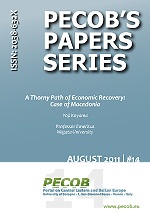and Balkan Europe
by IECOB & AIS Università di Bologna

This area collects and offers a wide range of scientific contributions and provides scholars, researchers and specialists with publishing opportunities for their research results
A Thorny Path of Economic Recovery: Case of Macedonia
August 2011 | #14
by: Yoji Koyama
pp: 30
ISSN: 2038-632X

- [paperEdition]
Abstract
Macedonian nation did not have its own state until the 20th century. After World War II Macedonia formed a Republic within the Socialist Federal Republic of Yugoslavia (former Yugoslavia). The region where Macedonians live is not confined to this Republic but it extends over to the western part of Bulgaria and the northern part of Greece. This fact has been an underlying cause of disputes with the neighbouring countries. With the disintegration of former Yugoslavia in 1991, Macedonia became an independent state. The newly-born country was admitted to the United Nations in April 1993. Similar to other Republics of the former Yugoslavia, Macedonia had to carry out double transition, i.e. transition to a market economy and transition from a regional to a national economy. The Republic of Macedonia has ethnic minorities within the country. According to the census of 1994, Macedonians had the biggest population (66.6%), followed by Albanians (22.7%), Turkish (4.0%), Romanies (2.2%), Serbs (2.1%), and Vlachs 0.4%. Others and people who undeclared their nationalities accounted for 1.9% and 0.1% respectively (Macedonian Academy 1997: XII).
The Balkan Peninsula has been a region where battles were often repeated as it has been called ‘Europe’s powder keg’. With the regime change, ethnicity problems, which were contained during the socialist period, came to surface. It is still fresh in our memory that ethnic conflicts occurred after the breakup of the former Yugoslavia and also in 1999 over the Kosovo problem. A group of countries – Albania and successor countries of the former Yugoslavia excluding Slovenia – is called the Western Balkans by the European Union (EU). In May 1999 the EU launched a new approach to the Western Balkans, i.e. ‘Stabilization and Association Process’ (SAP) which was different from the approach to Central European and Baltic countries.
For a newly independent small country to survive a market economy, it is required to tackle the following tasks:
1. to settle domestic conflicts,
2. establish good relationship with neighboring countries and
3. secure economic independence. Western Balkan countries, which have experienced ethnic conflicts and still have domestic ethnic problems, would not be assured of their survival as long as they remain outside the European Union. Therefore, a prospect to joint the EU is very important for these countries.
This paper examines how Macedonia has been tackling the above mentioned tasks, proceeding toward EU accession in the context of the EU’s Stabilization and Association Process. In the discussion Slovenia, which consisted of the former Yugoslavia and is now an EU member country, is utilized as a benchmark.
Keywords
Macedonia, EU Accession, Stabilization and Association Agreement (SAA), Ohrid Framework Agreement, CEFTA 2006
Table of contents
Abstract
Keywords
1. Introduction
1. Transition to a Market Economy and Formation of a National Economy
2. EU’ Stabilization and Association Process
3. Crisis within the Country and Support by the EU
4. The Macedonian Economy in the 21st Century
4.1. Weakness of the Economy
4.2. Regional Economic Integration
4.3. Impact of the Global Financial Crisis
5. Steps toward the EU accession
6. Lessons from Slovenia’s Experience
Conclusion
References
Periodicals
Download the paper
Version
Ver.: 01
Time stamp: 201108251130


 Download the full paper!
Download the full paper!





